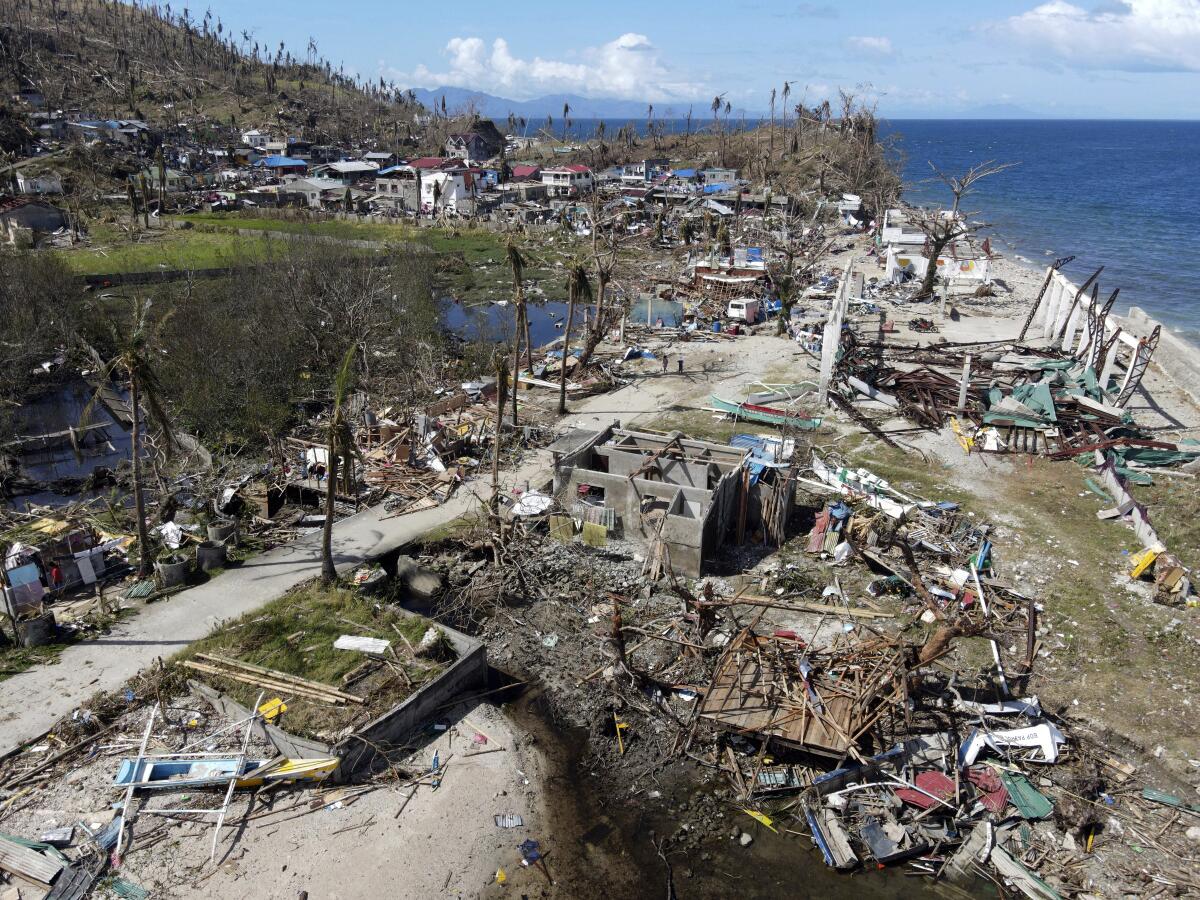6 ways to donate to Typhoon Rai relief in the Philippines

- Share via
After making landfall in the southern Philippines on Dec. 16, Super Typhoon Rai left a trail of destruction, killing at least 375 people and injuring more than 500, with more than 50 others still missing, officials said this week.
With many homes and shelters leveled, thousands of Filipinos remain without housing, transportation, communication, power, food and water.
Equivalent to a Category 5 hurricane, Typhoon Rai, known in the Philippines as Odette, carried 121-mph winds that gusted up to 168 mph. It was the strongest storm of the season for the Philippines, which often feels the brunt force of typhoons that are growing in number and intensity due to climate change.
Although Philippine President Rodrigo Duterte pledged to send $56 million in aid to the affected regions, the cost of repairs is estimated to be much higher.
If you want to help people affected by the most recent typhoon, it’s important to think about where you’re giving your money.
Tanya Gulliver-Garcia, a director at Center for Disaster Philanthropy, an international donation hub, suggests that people look at the type of work an organization does and check for groups that have roots in the community and partner with and empower residents.
Though large international organizations collect most of the initial donations and provide a large bulk of the immediate disaster relief, it’s important to find groups that are interested in the long-term sustainability of a community, said Donna Callejon, who heads GlobalGiving, another international hub for donors.
“We try to support organizations that were there before the white [relief] trucks and cameras show up and are there long after the white trucks and cameras leave,” Callejon said.
As far as how people can directly help, sending money remains the most effective means of support. Sending things such as clothes and supplies directly to disaster sites may inadvertently clog relief efforts, Gulliver-Garcia said.
Both Callejon and Gulliver-Garcia suggest running searches of organizations through platforms such as Charity Navigator and GuideStar before donating. They said to look for signs of transparency, such as regular audits and updated reports on how their donation money is being used.
While it’s important to do your homework before donating, Gulliver-Garcia said she also sees the value of giving directly to smaller grass-roots mutual aid groups or even to individuals who may have more direct connections with donors’ relatives or friends in the Philippines. “That moves faster than any international money does,” she said.
Here is a list of organizations people can donate directly to, including some suggested by Gulliver-Garcia and Callejon. Some groups are based in Southern California, others across the U.S., but all are connected to or are partnering with local organizations in the Philippines.
Pilipino Workers Center
Based in Los Angeles’ Historic Filipinotown, the Pilipino Workers Center primarily advocates for the labor and immigrant rights of workers across Southern California. It is collecting donations that will fund grass-roots organizations in the Philippines that are providing clean drinking water and generators for electricity. Donate Here
UNICEF
UNICEF has a fund to aid children who are in need of safe drinking water, sanitation, hygiene, nutrition, education and child protection. Much like others on this list, it does local work in the the Philippines year-round. Donate Here
Center for Disaster Philanthropy
The Center for Disaster Philanthropy is a nonprofit that acts as a platform for donors, both individual and corporate. It steers funds to organizations that have local roots or are invested in the medium- and long-term recovery of communities in the Philippines. It also has a partnership with Google to raise money for typhoon relief. Donate Here
Global Giving
Global Giving is a nonprofit much like the Center for Disaster Philanthropy, guiding funds to organizations that are providing help for both immediate needs and medium- to long-term support in the Philippines. In addition to a general disaster relief fund, Global Giving allows donors to choose to give to a specific regional project based in the Philippines. Donate Here
Lokal Lab
Based in Burgos on Siargao Island, which was hit directly by Typhoon Rai, Lokal Lab is rushing food and water to affected areas in the region. Long term, Lokal Lab officials say, they plan to rebuild homes damaged by the storm. Meanwhile, the organization runs projects that address food insecurity, joblessness, education and art. It also has a transparency report for donors. Donate Here
Kids for Kids
Kids for Kids is based in the Philippines and is sending teams with food and water to affected areas. Funds will also go toward purchasing housing materials, and fuel for boats and trucks. Kids for Kids provides educational programs for youths, primarily focusing on the effects of climate change. Donate Here
Email [email protected] if you’d like to suggest other organizations to add to the list.
More to Read
Sign up for Essential California
The most important California stories and recommendations in your inbox every morning.
You may occasionally receive promotional content from the Los Angeles Times.











